|
https://ift.tt/2YvLqmb
Pinterest Adds a Shopping Section to its Home Feed via @MattGSouthern https://ift.tt/2ylDFoi Pinterest is putting its shopping capabilities front and center with a new addition to its home feed. There are now even more ways to shop on the Pinterest app, with new capabilities that include personal recommendations and browseable catalogs. RecommendationsA personalized shopping hub now appears at the top of the home feed, which connects users to a curated catalog of shoppable pins.  Products are recommended based on previous activity, and can be purchased by the user immediately. CatalogsBrowseable catalogs will now appear below shopping pins, allowing users to quickly view more products from the same retailer. 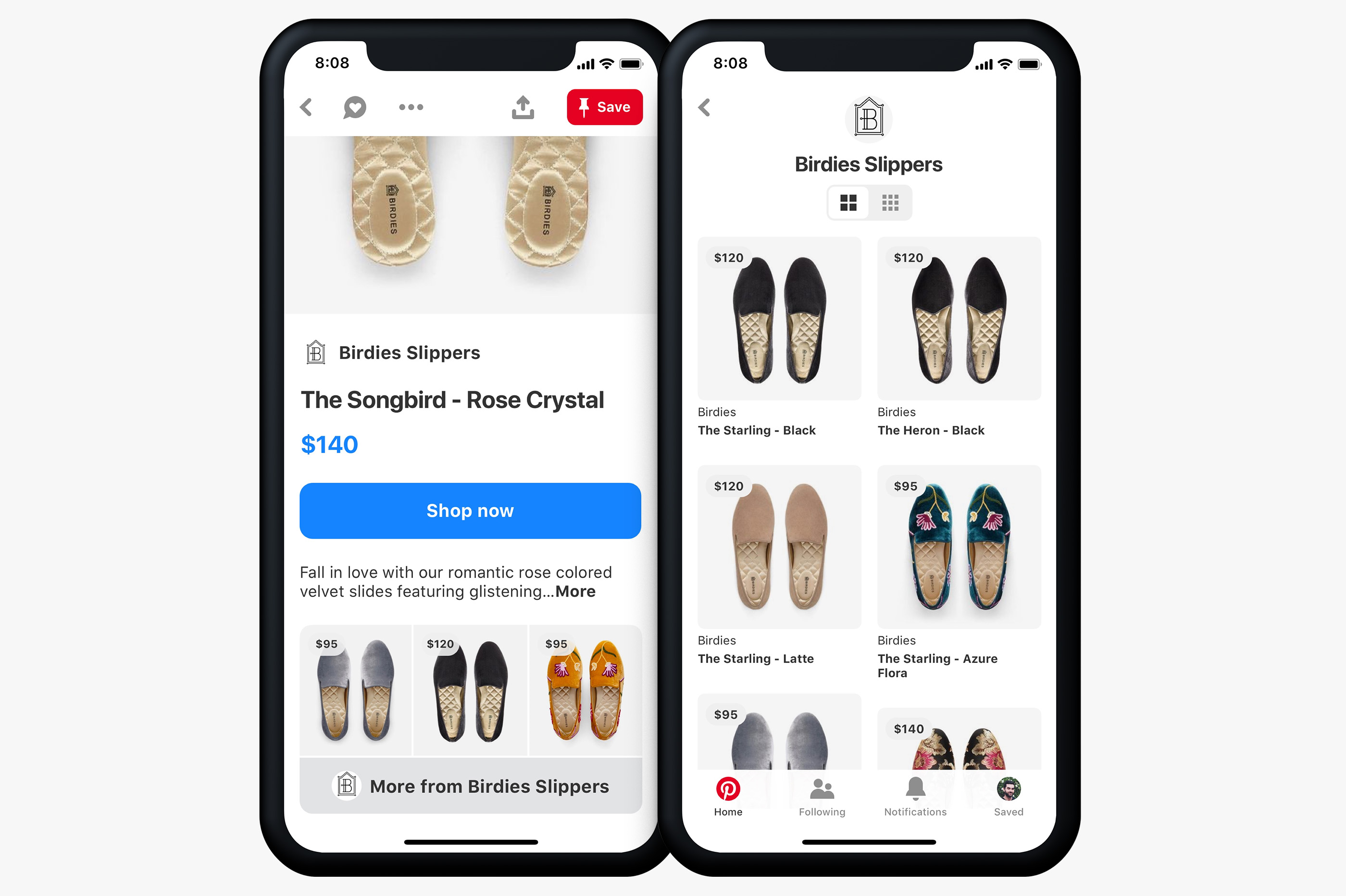
Pinterest cites a recent study from Neustar on the effectiveness of shopping ads, which finds retail brands saw twice the return on ad spend on Pinterest compared to other social media. The company says this is the latest update in an ongoing effort to make Pinterest more shoppable. SEO via Search Engine Journal https://ift.tt/1QNKwvh July 30, 2019 at 05:33PM
0 Comments
https://ift.tt/2KbXjIR
Facebook Updates Business Manager With Improved Design & Navigation via @MattGSouthern https://ift.tt/2YfjgAG Facebook is rolling out several updates to Business Manager designed to compliment the new features launched earlier this year. With a new design and navigation, users should find it easier to manage assets and permissions in Business Manager going forward. When opening the new Business Manager you’ll first see a new shortcuts tool which offers fast access to different sections based on previous activity. 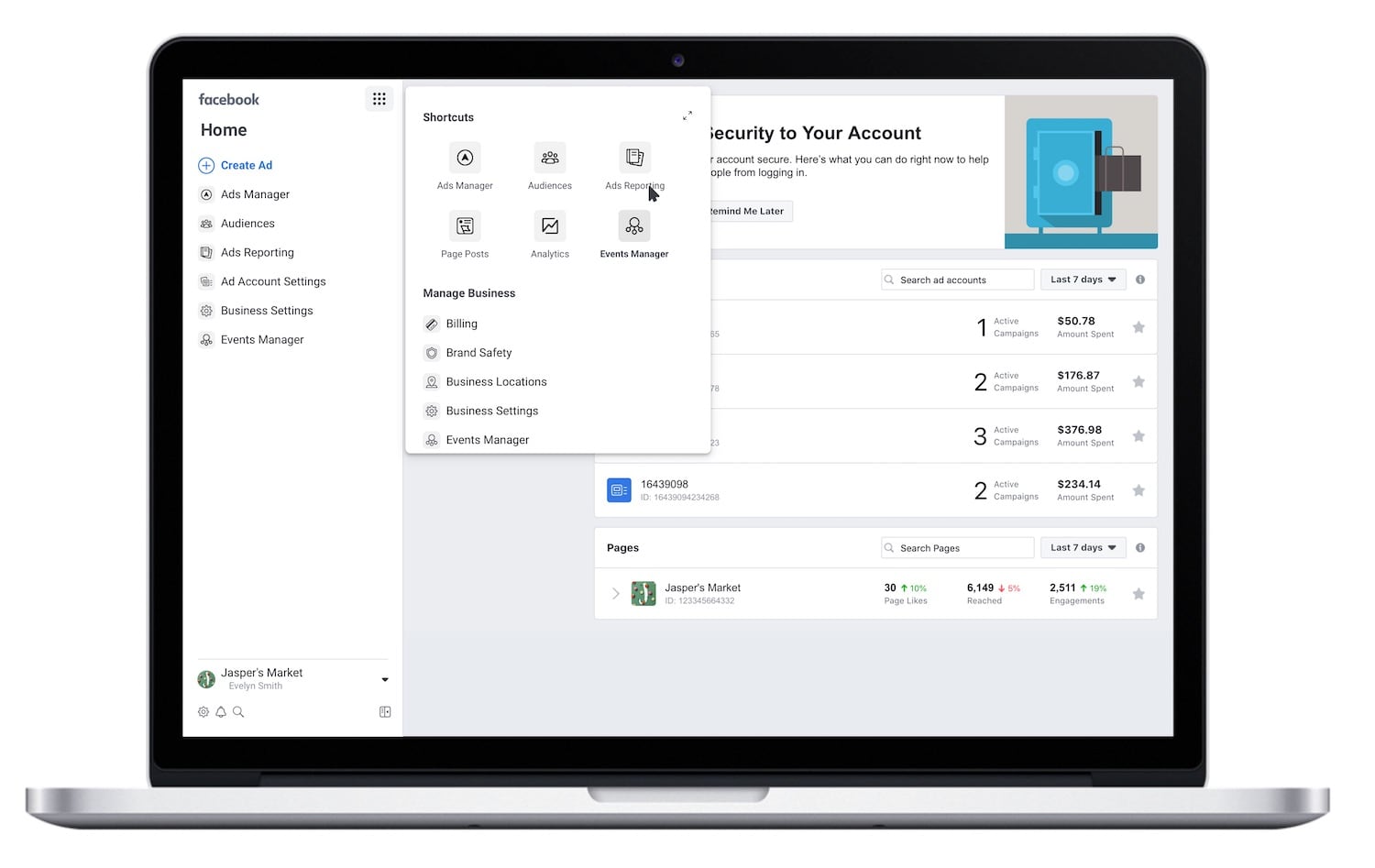 Here’s what else is included in this update to Business Manager:
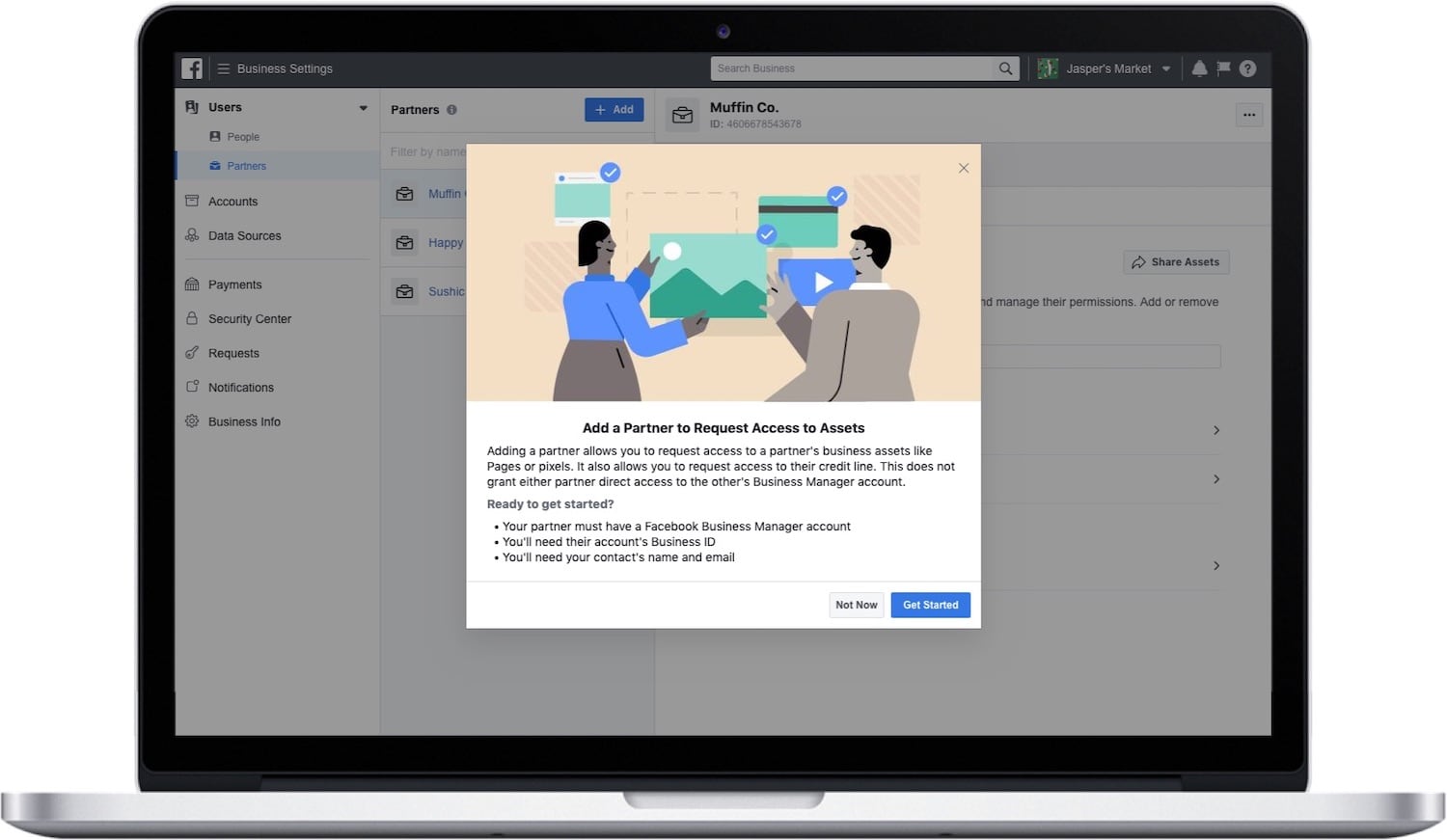
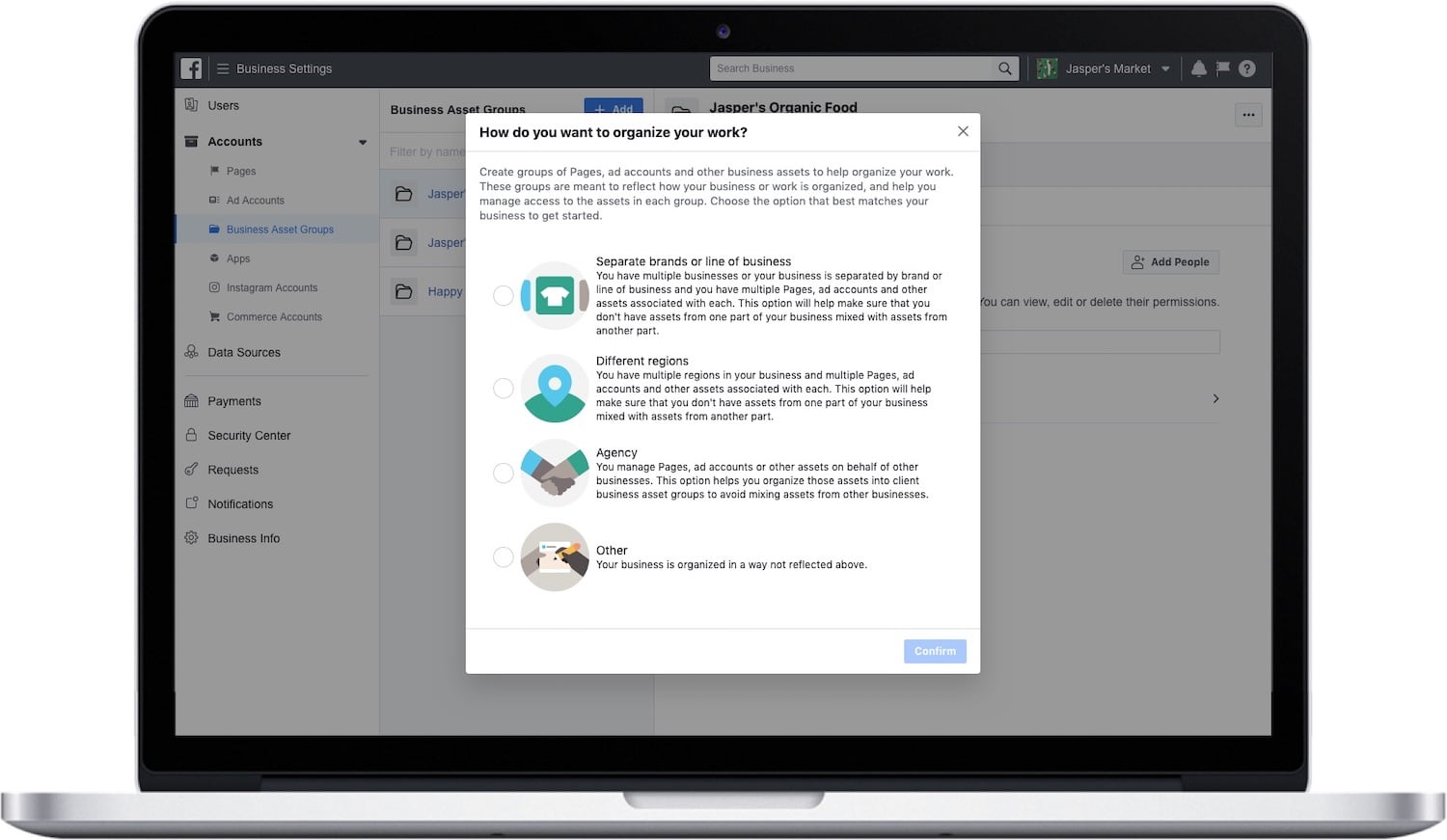 SEO via Search Engine Journal https://ift.tt/1QNKwvh July 30, 2019 at 04:36PM
https://ift.tt/2MsNcCm
Sharpen your search marketing skills with an SMX workshop https://ift.tt/2K3oQ08  Last week, I shared with you the brand new SMX East agenda… a firehose of 70+ sessions covering all aspects of integrated search marketing: SEO, SEM, agency operations and management, local search marketing for multi-location brands, CRO, analytics, attribution, content, video, mobile, tools, and beyond. Last week, I shared with you the brand new SMX East agenda… a firehose of 70+ sessions covering all aspects of integrated search marketing: SEO, SEM, agency operations and management, local search marketing for multi-location brands, CRO, analytics, attribution, content, video, mobile, tools, and beyond.
But I know that for some of you… 70+ sessions (in two days?!) isn’t enough. SMX Workshops were designed for over-achievers like you. These immersive training seminars, hosted by recognized industry experts, are the perfect way to kick off your week in NYC. Join us on Tuesday, November 12 from 9:00am – 5:00pm for your choice of full-day, in-depth workshops including: Advanced SEO TrainingSpend a day with a master SEO and come away with cutting-edge SEO techniques – tackling RankBrain, voice search, AMP, featured snippets, and more – that can help raise your rankings and visibility in search engines. Learn more here. Workshop Presenter: Bruce Clay Advanced Google Ads TrainingEven with all of the new marketing channels that have opened up over the years, Google Ads (formerly AdWords) is still the core of many companies’ interactive campaigns. If your PPC campaigns are not running efficiently, it can have a drastic impact on your bottom line. Join Brad Geddes for a full day of advanced Google Ads training and discussion that will teach you not only the best practices but also advanced concepts and strategies that are based on a decade of research and testing. Learn more here. Workshop Presenter: Brad Geddes Hardcore Technical SEO Tactics & TechniquesDo you deal with big SEO problems? Do you work in a large enterprise, or have a site with millions (or billions) of web pages? If so, the basic SEO training material is not what you’re looking for. You’re looking for the master class, the one that is loaded with advanced content. Topics include how to analyze and solve a variety of thorny technical SEO challenges, how to create and implement progressive web apps, PWAMPs, how to understand the impact of machine learning and AI on search. Learn more here. Workshop Presenter: Eric Enge In-House SEO ExchangeJoin Jessica Bowman for a full-day of “open the kimono” knowledge sharing in the only event designed by in-house SEOs for in-house SEOs. Because attendees are all in-house SEOs, the walls come down and you get to talk to the people actually doing SEO at the big brands, build relationships, and share solutions that you would normally only hear behind closed doors. There is no other workshop with this level of sharing! Learn more here. Workshop Presenter: Jessica Bowman Content Marketing for SEO (new!)Struggling to get your marketing team on board with why and how to do content marketing for SEO — in such a way that helps achieve organic growth? This workshop is for you. Speaker, author, and leading expert Michael Brenner will discuss the SEO context and business case for content marketing. He’ll walk you through a roadmap that any SEO expert can use to get their marketing teams on board to deliver the organic reach, engagement, and conversions clients demand. Learn more here. Workshop Presenter: Michael Brenner Video for Search Marketers (new!)Video is dominating the content landscape, but because traditional video production is expensive, complicated, and slow, it’s often underutilized by many search marketers. Join marketing and video expert Michael Hoffman for a full-day workshop exploring the best practices and secret hacks for making video a powerful driver of both organic and paid search programs. You will also learn how to leverage new and lower-cost ways to produce video that you can use to quickly scale your video marketing campaigns. Learn more here. Workshop Presenters: Michael Hoffman and Rami Atassi Search Marketing Boot CampSearch marketing can be overwhelming when you are just starting out. That’s why we created the Search Marketing Boot Camp — a one-day pre-conference experience set of sessions that will prepare you to implement traffic- and revenue-boosting search marketing techniques immediately. It’s perfect for those new to search marketing or needing a refresher! Learn more here. This is your chance to learn from some of the smartest search marketers on the planet. Don’t miss out! Ready to register?There are two different ways to attend depending on your goals and budget:
So — which workshop will you choose? Register now and I’ll see you in NYC! About The AuthorLauren Donovan has worked in online marketing since 2006, specializing in content generation, organic social media, community management, real-time journalism, and holistic social befriending. She currently serves as the Content Marketing Manager at Third Door Media, parent company to Search Engine Land, Marketing Land, MarTech Today, SMX, and The MarTech Conference. SEO via Search Engine Land https://ift.tt/1BDlNnc July 30, 2019 at 03:20PM
https://ift.tt/2MnQ8Qm
Google Rolling Out Updates for Android Auto via @martinibuster https://ift.tt/2Ywiw9G A new previously announced interface for Android Auto (automobiles) is rolling out. As Android Auto becomes widespread more and more local search site visitors may be coming from autos. While Android Auto focuses heavily on apps, this may still be reflected in greater adoption and an increase in calls and visits for local search related businesses. New App LauncherThe Android Auto interface features a new app launcher that shows the most frequently used apps up top. Activating a media player like Spotify will begin playing where you left off. A new navigation bar that sits at the bottom of the screen allows you to control a media app like Spotify while using the a map app. 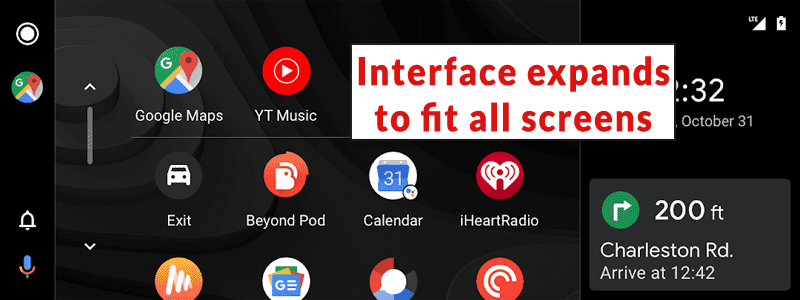 The new Android Auto features a dark mode and easier to read fonts. Android Auto seems to be focused primarily on Apps. But local search businesses may benefit as more and more drivers begin asking Google to tell them the location of the nearest restaurant or other businesses. 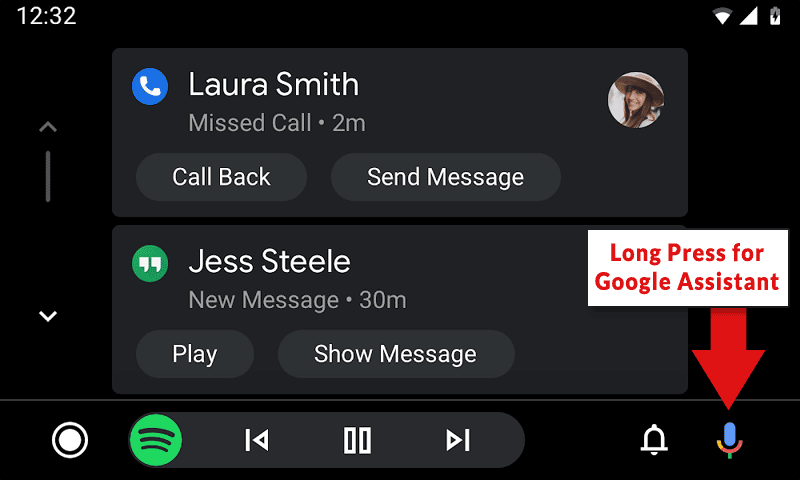 This may mean that implementing JSON-LD structured data may become increasingly important as well as a good local search presence. Some of the Android Auto features will migrate to Driving Mode in the regular Google Assistant for mobile devices in the future but not now. According to the official Google announcement:
Read the official announcement here: Upgrade your drive with Android Auto SEO via Search Engine Journal https://ift.tt/1QNKwvh July 30, 2019 at 02:30PM
https://ift.tt/32XUSlG
Google Chrome Now Supports Dark Mode Preference via @martinibuster https://ift.tt/330RGWr 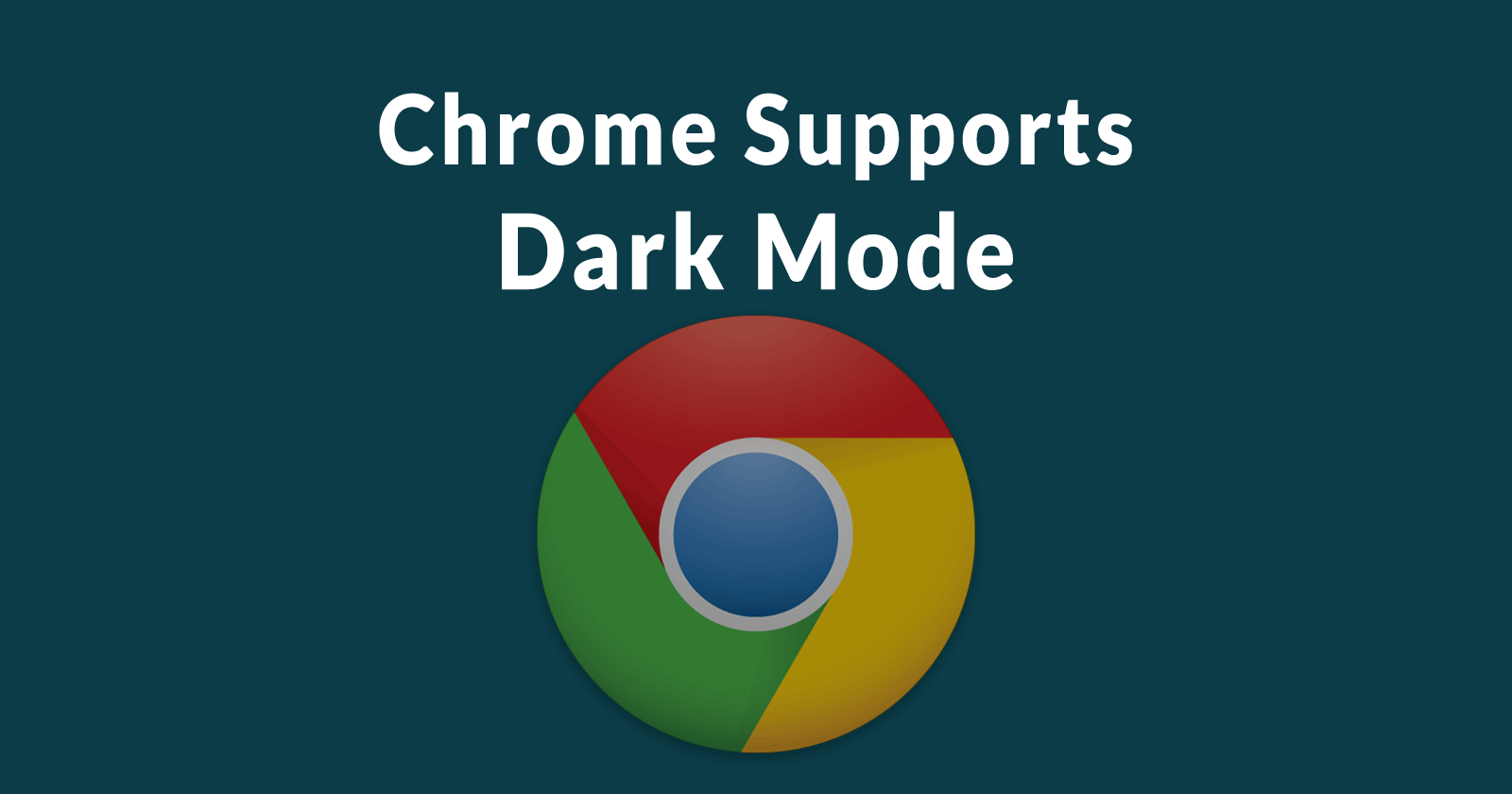 Google announced support for prefers-color-scheme media query. This means Chrome will display web pages with dark mode color schemes if a user indicates a preference for dark mode. This change begins in Chrome 76. Beginning with Chrome 76, web developers can now show Chrome visitors a dark mode version if the user sets that as their default viewing preference. Dark Mode is an OpportunityDark mode allows users to browse your site under dark settings. Creating a dark mode version of your site allows you to provide your content to these users in a way that accommodates them. This is good for the publisher because it will keep that user happy and on your site longer. Some forum and WordPress theme templates come with dark mode alternative stylesheets. But you will probably want to update those so that they are optimized for legibility. CSS-Tricks.com has an article listing some of the customizations you may wish to consider. For example, there’s a way to make images darker with CSS so that they display better in dark mode. Dark Mode and AccessibilityDark mode addresses accessibility concerns. Some sight impaired people have an easier time browsing web pages in dark mode. Others use dark mode because it reduces eye strain. Dark Mode Preferences Browser CompatibilityAccording to Mozilla’s developer page on browser compatibility for prefers-color-scheme media query, many major browsers now support dark mode. Desktop
Mobile
Microsoft Edge and Explorer plus Opera do not currently support dark mode for the desktop. Opera for Android does not support dark mode for Android mobile devices. According to Google:
Google’s Material Design PageGoogle has a Material Design page that discusses the principles of designing for dark mode. In it they suggest:
As you can see, a dark mode theme is more than inverting colors, turning black to white and white to black. You may have to choose a less stark contrast for text legibility. Should You Turn to the Dark Mode?There are many reasons to add a dark mode version of your site. Allowing users to view your site in dark mode is not only good for users but it may be good for your site and user satisfaction metrics. Further reading: Read Google Chrome announcement: Google’s Material Design page on Dark Mode Themes Mozilla’s Developer page on prefers-color-scheme media query Article about considerations when redesigning for dark mode SEO via Search Engine Journal https://ift.tt/1QNKwvh July 30, 2019 at 02:26PM
https://ift.tt/2ZnkZ3o
SMX replay: Visualizing Auction Insights data for competitive intelligence https://ift.tt/2K3PA0E Understanding the metrics in Google’s Auction Insights and visualizing the data can give a clearer view of your account’s performance. James Hebdon, co-founder and CTO of Paid Search Magic, shared techniques for using Google Sheets and Scripts to transform Google Ads’ Auction Insights data into a clearer and more compelling report to your boss or clients. Listen to Hebdon’s full Insights session talk from SMX Advanced last month, above and continue reading for his tips on how to handle your Auction Insights data. The full transcript is also available below. bonus tips. When analyzing Auction Insights or communicating your findings with clients, Hebdon suggests that you keep the following in mind:
More Insights. During Insights sessions, experts deliver actionable tips and useful information for digital marketers. Here are a few more sessions you can stream right now: If you found these sessions informative, consider attending them live on November 13-14, at SMX East in New York. The full transcript.Introduction by George Nguyen: Auction Insights tools in Google and Bing can provide valuable competitive intelligence and bidding insights, but it can also be easy to misconstrue what the reports are telling you if you don’t know exactly how they’re designed to work . By understanding the metrics provided under Google’s Auction Insights and visualizing the data, you can gain a clearer view of your account’s performance. Welcome to the Search Engine Land podcast, I’m George Nguyen and, on this edition, James Hebdon, co-founder and CTO of Paid Search Magic is going to share his techniques for using Google Sheets and Scripts to transform the information from Google Ads’ Auction Insights into something that’s easier to understand, and is more useful and more compelling to your boss or clients. Before I hand it off to James though, I’d like to encourage you to check out our other SMX replays — we’ve got another one with tips on improving your YouTube ad performance — you can find that on the Marketing Land SoundCloud stream or as a link in the article that accompanies this episode. Here is James now, with his Insights session from SMX Advanced. James Hebdon: Hey everybody, my name’s James Hebdon and I am the CTO and co-founder of a boutique paid media agency called Paid Search Magic. And today I am talking to you about a tool called Auction Insights, which is a free Google tool that they provide to give you some limited insights into some competitive behavior. Now, the reason why I wanted to talk about this is that it’s a broadly misunderstood tool. A lot of people have used it; if you go and do a search on YouTube, you’ll get lots of really flashy images that talk about, you know, spying on your competitors. It’s a much more limited tool than that. But if you know how it works and you know how to treat it right, it can give you a lot of insights into your competitors. Now, early on in internet marketing, there were a lot of academic journals that started getting published about auction theory, applying game theory to auctions, bidding techniques, things like that. And, one of these earlier papers, the researchers were surprised to find out that, unlike a lot of traditional auctions or auctions like eBay, people that were working within Google Ads . . . didn’t exhibit the same type of irrational behavior that people did in other areas; it’s called, you know, “the joy of winning,” or “auction fever.” And they speculated that this was because, unlike these other auctions, the bidders are secret, the bids are secret and you don’t know who the winner is. But they didn’t really drill into it more than that because it wasn’t the focus. But, a more recent paper that was released by Princeton, they got a bunch of volunteers together and they sat them down in front of a computer terminal and they instructed them on how to deal with auctions, like the best way to do an auction. And, when these people thought that they were competing against the computer, they took the instructions, they did it properly and they managed to not overpay, which is kind of the metric that was used in the study. However, when they were told that they were competing against humans, almost without exception, the volunteers — even though they had been instructed in how to do it right — they almost all found it impossible to behave rationally. And, that’s just part of the human condition, right, is that we have a difficult time with that. So, the reason why I’m bringing this up is because using auction insights data can be really, really compelling. In fact, one of the most common uses of it is to show it to clients because when they see that, in front of them, you know, the different competitors that are coming up, how aggressive they are, and you use some of these other techniques we’re going to talk about to show them how they’re behaving, it can really compel a different behavior. They can be more interested in bidding and protecting their brands, things like that. But, you have to use caution because it can also get them to focus on the wrong KPIs.  Now, another thing you got to understand about how Auction Insights works is that it is much narrower in scope than a lot of people think. So, in this whole keyword universe thing here you have a single search term that is triggering a bunch of different keywords, right? And, sometimes they can be really, really different keywords. And, over the past several years, Google has been taking several different steps to broaden the match typing that is going on, making many more people eligible for auctions. So, the Auction Insights data exists in kind of this narrow intersection that brings up the first metric, which is called an “overlap rate.” And, only in that little overlap, where both you and your competitor are participating in or are eligible for those auctions, do you get any visibility into what they’re doing. Everything that’s on the outside of those circles, you don’t get any information. Now, Google has a lot of techniques that they use for like budget smoothing and things like that. And, one of those things is that, you know, they have some techniques to try to efficiently exhaust advertiser budgets and they do that through a selection process of determining who’s eligible. That’s not always consistent and it’s not always known, which introduces another unknown element to the types of information that you can infer from Auction Insights data.  So, with kind of all this stuff out of the way, like this is stuff that you need to understand so you don’t pass on bad information — so you don’t take irrational, budget increases or bids or anything like that. These are the metrics that are available with an Auction Insights. The foundational one is that overlap rate because it indicates exactly how much that competitor is overlapping with your keyword set. It’s an indicator of how much like your company they are — basically, how much their product set, how much the keywords that they bid on are similar to yours. So, if you use that as an indicator of that, then you can make a lot better use of the other ones. Things like impression share, average position, are just weak metrics. Average position is going away for a good reason — it’s because it’s a bad indicator; it’s easily skewed data. The stronger metrics are top-of-page rate, absolute top-of-page rate, position above rate — those all indicate how competitive people are. So that’s the foundation — that’s the things that you have to know just so you don’t screw up the rest of it. Now, the state of automation right now is such that there’s no API or script access to Auction Insights data. There is some limited access through Data Studio. It doesn’t give you a lot of the transformations that you can get from just downloading the data straight from Google Ads. The template that I use and that is available via a link at the end of this presentation uses Google Sheets as its primary, like, data drop zone. So, you can just like take the data from Google Ads, drop it in there and then it automatically populates all the visualizations and everything that you need.  Now, I can’t go through all the formulas and everything like that, that you would use in something like, you know, an Auction Insights template. But, it’s good to know like just the steps of it so that you can make changes to it if you want, so you can build your own if you want, and the first part is just getting the raw data. You have to determine, first of all, the date range that you want to look at, the time segment that you want to look at. So, 30 days, by day, you know, past 30 weeks, whatever; you have to get the start date and the end date, download the data. Then you have to focus on the actual area that you want to. And this can be really tricky because if you just look at campaign data, like at an account level, you will get garbage, you’ll get a general idea of all the different competitors that are in the market, but you’ll have no idea of what they’re really doing, especially if you’re running both search and shopping campaigns. Never mix that kind of data because it’s so fundamentally different that it skews anything useful that you might get from it. Generally speaking, the higher level that you go, the less precision and the less you can confidently infer from the data. When you do segmentation, you can also segment the data by device and increasingly this is a big deal because the user behavior when it comes to device types is so fundamentally different. Metrics like average position is not worth even looking at it if you’re combining all those different devices together. Position one on a mobile device is a much different thing than position one on a desktop. If you combine the data, then you’re not getting anything useful from that.  Now, the next thing that you got to do in any sort of a template is you need to smooth the data. Even if you’re doing this by hand, you have to do this. So, like one of the metrics, search impression share, if you have less than 10%, it will add like some dashes and some brackets and things like that; you have to clear that out. By using a template, by using these functions, like the little substitute thing at the bottom there, you can take those off automatically, so you never have to deal with it. Again, the whole idea of this automation is that you do at once, you never have to do it again.  Now, the biggest thing you have to do with data curation is that you actually have to prioritize the competitors that you’re looking at. You can have 30 competitors that will pop up in Auction Insights data that you download. This is a graph of what they look like. If you graph all of them. There’s almost nothing useful that you can get from that. Maybe a couple of peaks that you could dig into a little bit more. But other than that, it’s just noise. However, if you can rank them, if you can rank your competitors in some way, then you can get something that is a lot more useful. Something that indicates actual behavior and how it might be impacting you. The way that we do that is going back to the, you know, all-important overlap rate. You use that as a foundation. You add it to a multiplier, you add the rest of them up and it’s going to give you a much better indication of who your primary competitors are because there’s going to be a lot of like little competitors, especially on Microsoft Ads. You’ll get a lot of ad arbitrage sites and things like that. So, you get these top competitors and now you have a nice list and you can focus on just the top few.  So, the final thing, and this is the good part, is that you start getting to the actual visualizations. You have the data. It’s automatically populated. These formulas, you can go back and look at them and they’re also on the link at the end. But, when you get all that done, then you can start getting these nice clean visualizations. Now you can actually see if there are changes that are occurring when you’re trying to analyze for performance fluctuations or if you’re trying to determine what the impression share is or entrance into the market, things like that. Another tip, that when you are looking at impression share, if that’s an important metric to you, you need to take it out to really analyze your competitor to behavior. Because of the way that this Auction Insights data is calculated, if you leave yourself in, it will skew all the rest of the data and you can’t really indicate anything from it. By using overlap rate, you can — these are, by the way, all actual data from clients that have been anonymized — but you can actually see new people that are entering into the market. It’s really useful to see that, especially if you start seeing your CPC fluctuations. It’s a great way to identify seasonal competitors. You see Amazon in here, they, all the way up until right before Christmas, they’re incredibly competitive with this client. Then they just drop out to nothing during the Christmas season and then they go back up to just a bare presence. Now, the last thing on this is just overlaying other metrics. The key thing here is just to make sure that you are using the same date range and the same time segment. As long as you have that as your core, then you can compare it to the Auction Insights metrics and if you see a competitor that suddenly starts to rise in position, that’s probably a pretty good indicator that your CPCs are going up or that your average position’s going down. Now, there’s a lot that you can do to draw conclusions from this data: You can do things like identify bad faith affiliates. I’ve done that, where basically you find out that they are bidding on your client’s brand against rules. You can determine competitors that are conquesting, where they’re targeting your brand terms specifically. Auction Insights myths, this is the last thing: You cannot back your way into competitor budgets and you cannot determine the keyword set of a competitor. The data’s just not there. Microsoft ads is a little bit different. They do provide this data. The core metrics are a little bit different and you can only segment it by a limited amount of time, but outside of that and the general they have more noise in the data, you can apply the exact same template to that data as well. So yeah, so don’t be emotional when you’re looking at the data. Be careful on how you convey that information to your clients because they will take it and they will be compelled by it. Don’t be irrational in how you sell it to them, even if you really want them to raise that brand budget because it can backfire in a big way. Besides that, just make sure you understand the data and use automation because it will save you enormous amounts of time and give you something that can really, really help you as you’re managing your clients. Thank you. About The AuthorGeorge Nguyen is an Associate Editor at Third Door Media. His background is in content marketing, journalism, and storytelling. SEO via Search Engine Land https://ift.tt/1BDlNnc July 30, 2019 at 12:26PM
https://ift.tt/2YseUkZ
Claim your Knowledge Graph: Here’s how https://ift.tt/2Otis6R Google has continued to expand the presence of its Knowledge Graph results and is now a common element in most search results. The Knowledge Graph is, of course, an organic search element and is closely tied to related elements such as featured snippets and rich results. It is now a common SEO practice to attempt to gain and optimize a Knowledge Graph result. A new feature that Google has added to its Knowledge Graph is allowing entities to claim their Knowledge Graph panel to become the authoritative owners and editors of the results within the panel. You may wonder why would Google offer this feature? Well, the answer is Google doesn’t always get things right and incorrect information can appear in Knowledge Graph results. This is a common issue in the era of fake news that we live in. Having control of your Knowledge Graph panel will ensure you can make the respective edits needed. Here is what Google has outlined as the benefits of claiming the knowledge panel.
Here is an example of the element which displays that the Knowledge Graph Panel is not claimed. It appears at the bottom left panels that are not claimed. 
Many brands and companies have not taken advantage of this feature and this element sticks out like a sore thumb in their SERPs. Here are two examples. 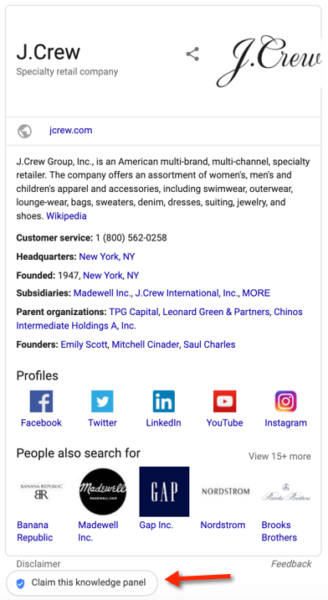
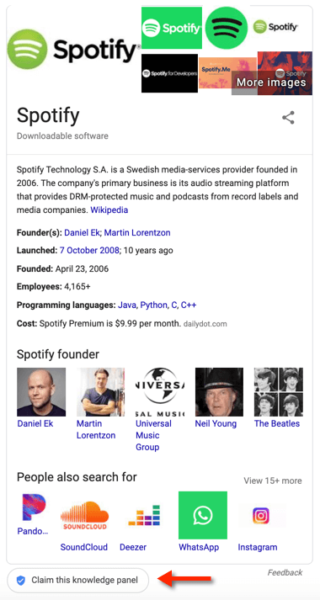
Claiming your Knowledge Graph panelHere is a step by step guide on how to claim your Knowledge Graph.


Options will typically include YouTube, Twitter and Google Search Console. Once you complete the verification the “Claim your knowledge panel” button will disappear from below your Google Knowledge Graph panel. You will now have authoritative editing power on your panel where you can suggest changes. So, if you have wrong info was appearing in your panel you now have the ability to have it updated. Here is what the editing of the Knowledge Graph panel looks like if you’re logged into your Google Search Console. account 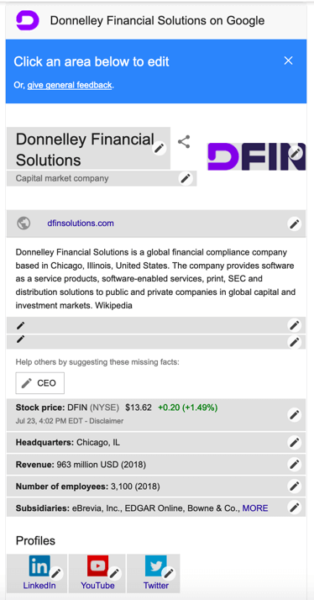
Opinions expressed in this article are those of the guest author and not necessarily Search Engine Land. Staff authors are listed here. About The Author
Tony Edward
is a Senior SEO Manager at Elite SEMand an Adjunct Instructor of Search Marketing at NYU. He leads the SEO team at Elite SEM's New York City office. Tony has been in the online marketing industry for eight years. His background stems from affiliate marketing and has experience in paid search, social media and video marketing. SEO via Search Engine Land https://ift.tt/1BDlNnc July 30, 2019 at 12:20PM
https://ift.tt/2YvtCf3
Analysis of SMB site builders finds connection between vendor and rankings https://ift.tt/2YglwHR Can the small business (SMB) website building platform you select affect your search rankings? An analysis of 150,000 SMB websites strongly concludes it can. Directory site FreshChalk evaluated the top SMB site builders, including Wix, Squarespace, GoDaddy, the Google My Business site builder, WP Engine and several others. The company found connections between sitebuilder/host, page speed and rankings. Wix the biggest, not the best. Among its sample of 150,000 SMB sites, Wix had the largest market share. That was followed by GoDaddy (15.6%), Squarespace (14.4%) and Square-owned Weebly (8.5%). Google My Business’s free site builder launched in 2017 and has grown fairly rapidly. It and WP Engine each had 4% share. Hibu (3.5%) and Thryv (2.6%) are former directory publishers that have transformed into SMB marketing services providers. 
Google wins on Google PageSpeed. FreshChalk found that Google’s site builder had the fastest page speed among the most popular site builders, which is a ranking factor, when tested using Google’s own PageSpeed tool. Market-share leader Wix had the slowest speed among the big SMB site builders/hosting providers. (The annotations in the charts below are from FreshChalk.) 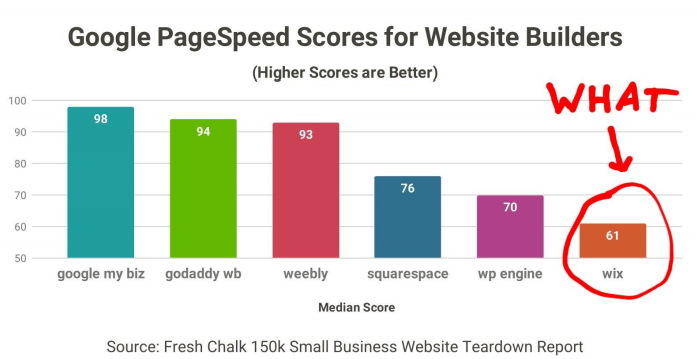
The scores among the providers with smaller market share among the sites represented in this study rivaled those with greater share. Carrot matched Google My Business’s page speed score of 98. Thryv (92) and WordPress (91)each had page speed scores above 90. Shopify (83) and Hibu (81) had scores in the 80s. 
WP Engine sites had best rankings. Despite GMB’s growth, FreshChalk said that there were too few organically-ranked GMB sites in its sample to make a comparison with the other vendors. The chart below reflects “median rank” based on an analysis of 11,000 sites within the FreshChalk sample. WP Engine was the rankings winner, followed by Squarespace. 
The study’s methodology is discussed in more detail in FreshChalk’s blog post. Why we should care. If these results are accurate it obviously has significant implications for the market and could sway vendor and hosting decisions on a large scale. All other things being equal, why wouldn’t small businesses automatically choose providers that maximized their ranking potential? Those providers would also be in a position to raise prices. Before we fully accept these findings and conclusions, others need to take a close look at this issue. The study needs to be replicated. At a minimum however, it initiates an important discussion and brings some transparency to the sitebuilding/hosting market, which has generally been lacking. SEO via Search Engine Land https://ift.tt/1BDlNnc July 30, 2019 at 12:07PM
https://ift.tt/2LP9kqL
The Essential Guide to Managing Expired Content via @jes_scholz https://ift.tt/2LVQjTV Many websites are built upon content that is by nature relevant for a finite period of time and routinely expires.
Such expired content often accounts for thousands of pages. With additional pages added to the pile daily. Taking an individual look at each page is unrealistic. You will need to manage expired content with an automated retirement plan. This plan should be both user and SEO friendly. Like many SEO topics, there’s no absolute answer. But there are six key considerations that help identify the optimal solution for specific circumstances. Do the expired content pages:
Answer these questions to find out if you’re an expired content hoarder, recycler, destroyer, cleaner or juggler. For clarity, expired content does not include:
Here are five options to manage expired content pages. 1. The Hoarder: Leave On-Site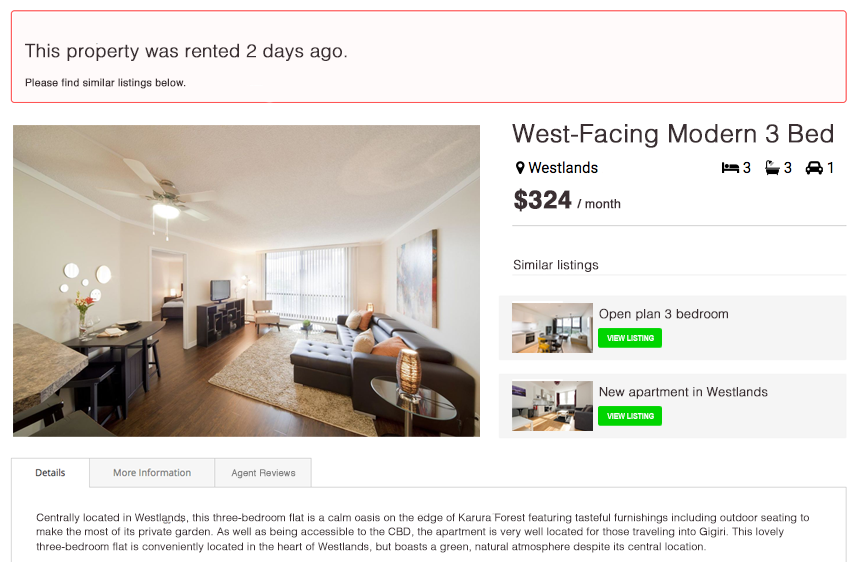 The simplest approach is to leave expired content pages live, adding an explanatory message and replacing the conversion form with related content recommendations. Out of all expired content handling options, leaving expired pages on-site maintains the highest amount of sessions. Obviously, expired content is less useful to users once it has past its expiration date. But in some situations, it can still offer value. For example, seeing the specifications of previous product models, the salary of past job roles, or details of sold property listings. The main problem with this option is that expired content will rapidly outnumber the site’s active content. This bloat causes competition for crawl activity, potentially delaying the indexation of fresh content. Google’s John Mueller commented, “what would happen is we would just index all of these old pages and we’d have trouble focusing on the important stuff on your website.” And as search engine spiders repeatedly hit expired content pages, which are by their nature stale and thus lower value, crawl budget may be negatively affected. What’s more, expired content pages split ranking signals and cause keyword cannibalization – challenging live content for rankings. As a result, your site may rank lower overall as search engines aren’t receiving clear signals. You can combat keyword cannibalization by removing expired content URLs from the search engine index with: Such deindexation methods allow sites to maintain the power of any backlinks for the domain – although naturally, with such commands the page-level rankings are moot. If you choose this option, be sure all expired content pages are excluded from CPC campaigns, internal site search, and dynamic XML sitemaps. You don’t want to be actively promoting content you no longer offer. Key Takeaways
2. The Recycler: 301 Permanent Redirect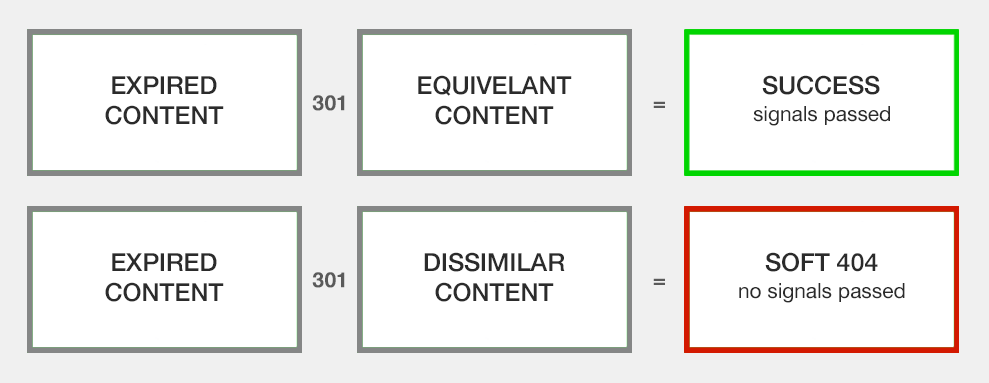 Redirecting your expired content to another page is a common solution, but the devil is in the locational details for SEO success. Firstly, ensure the redirect destination will stay on-site for the foreseeable future. Else redirect chains are created, which causes latency for users as well as take search engines time to follow and forward the ranking signals. Plus, after five chained redirects Google will reschedule the crawl, delaying indexation of the destination content. This effectively rules out horizontal redirects (item A to item B) if item B will also shortly expire and need to be redirected (item B to item C). Secondly, Mueller commented that any redirect should be to a page which can be seen as “a clear replacement”. Else it is seen as “essentially just a 404 that you are trying to do with a redirect.” In which case “what will happen is [Google] will essentially pick that up as a soft 404 page. And say oh, the webmaster probably did this wrong, and we’ll just treat it as a 404 on our side.” This is crucial to understand. 301 redirecting expired content to an irrelevant page, such as the home page or top level categories, is likely to be treated by Google as a soft 404 and so won’t pass ranking signals to the destination page. This may also rule out high vertical redirects (item A to category A). A vertical redirect location that will often meet these two critical criteria, both relevant and lasting, is a filtered subcategory page. How do you know you have the vertical redirect level correct? If not, you will see an increase in “Submitted URL seems to be a Soft 404” errors in Google Search Console. As an additional benefit, specific redirects reduce friction for the user by landing them on a page with a set of highly relevant alternatives. To further smooth the user experience, you can add a dynamically generated message explaining why they have been redirected. For example, when item A redirects to filtered subcategory A add a message that item A is out of stock but below are other similar items. Beware of the redirect message copy. Mueller has mentioned when Googlebot see a message that says “no longer available”, it may assume that it applies to the page itself. And again, the 301 redirect will result in a soft 404. Key Takeaways
3. The Destroyer: 404 Page Not Found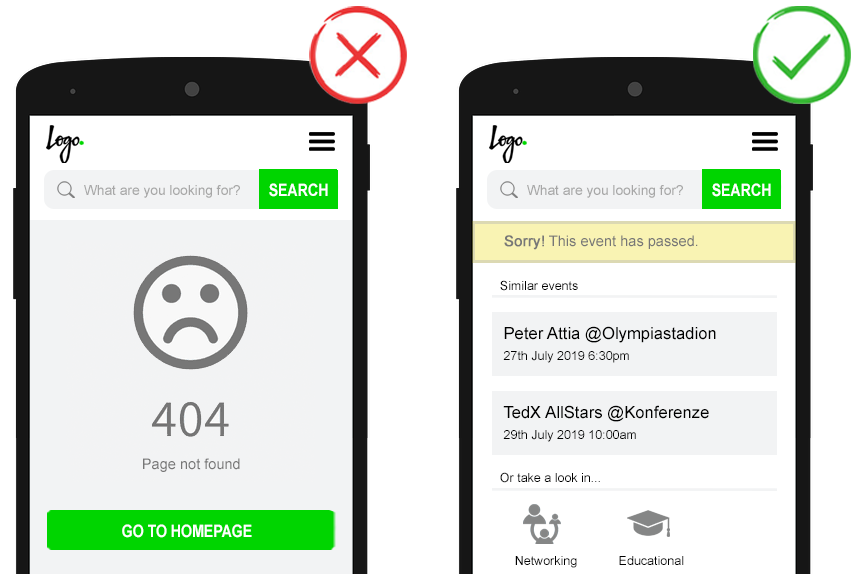 Amassing thousands of 404 errors can be loathsome for SEO pros fearing some form of penalty. This is understandable because they show up as errors in Google Search Console, which implies they need to be fixed. But it’s also indisputably wrong.
Plus, a 404 or 410 status code is one of three valid options to remove content in the Google for Jobs developer guidelines. What’s important to understand is that as the page will be dropped from search engine indexes any ranking signals the content has accumulated is lost to the 404 void.
On the plus side, only a small amount of crawl budget will be spent on expired content URLs. Googlebot will occasionally recrawl 404 pages, to see if they should reindex the URL. Google’s behavior is based on the assumptions webmasters often make status code mistakes. Let’s also take a moment to look at this from the user’s perspective You’re looking for a specific product, job opportunity, event, etc. You have found a link on a website or social media. Clicked it annndddd… Page not found. A generic 404 page is likely to cause a mix of disappointment and frustration. The majority of users will immediately bounce. Determined users may look for navigational help such as on-site search. However, as the content no longer exists, they won’t be able to find exactly what they clicked to land on. That is a lost conversion and a poor brand experience. To improve user experience, implement a custom 404 page that shows a “that item is no longer available” message and recommends relevant alternatives. Key Takeaways
4. The Cleaner: 410 Page Permanently GoneSimilar to a 404 status code, 410ing a page will lead to the loss of ranking signals and the 410 landing page should be customized. The difference is that a 410 status code tells crawlers that the page is permanently gone. As such, the expired content is removed from the index more swiftly. Key Takeaways
5. The Juggler: Combining Status CodesIf none of the above options ticks all boxes, there is no reason you can’t choose to combine the approaches above. For example, you could leave the page live for a set period of time to capture long-tail sessions of people may still be interested in the content and then change to a 410 when the visits no longer provide more value than the negative impact on crawl budget. Or for a classifieds website that allows reactivation of listings within 30 days. You could leave the page live for that period, and then implement a 301 redirect once reactivation is no longer possible. For fastest possible deindexation with minimal crawl, you could send double the directives by combining an unavailable after tag and a 410 status code when the content expires. Expired Content Handling Decision TreeClear judgment and a little bit of analysis are required to choose how to manage expired content. Get your data together and follow the decision tree to your ideal status code. 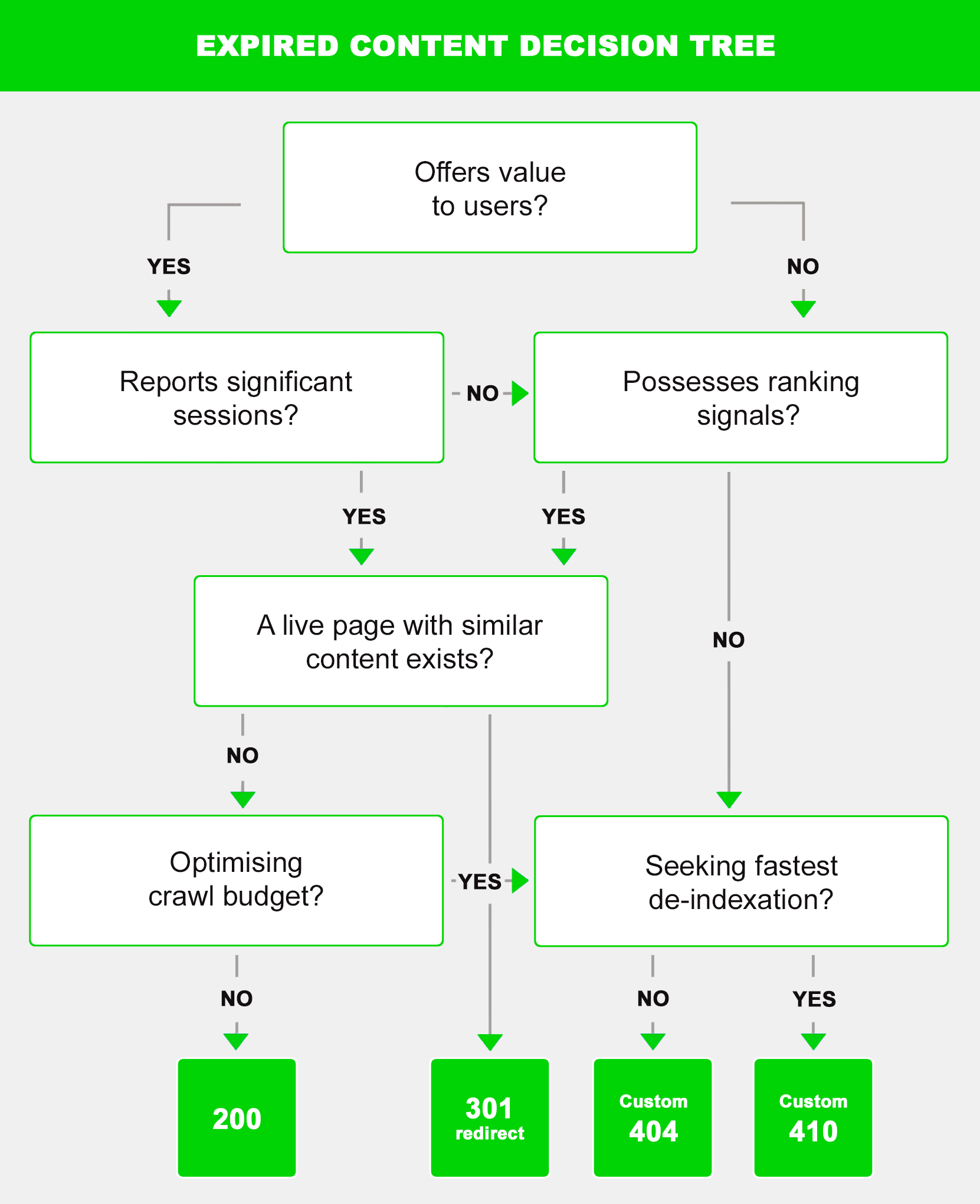 A Note on User ExperienceThere are many arguments that one of the above options offers a better user experience than another. Often, these expert opinions directly contradict one another. Here are the indisputable basics:
So, what’s your plan for expired content handling? More Resources: Image Credits Featured & In-Post Images: Created by author, July 2019 SEO via Search Engine Journal https://ift.tt/1QNKwvh July 30, 2019 at 11:33AM |
Categories
All
Archives
November 2020
|

 RSS Feed
RSS Feed
